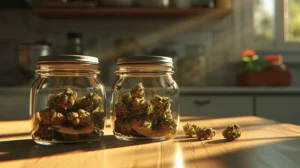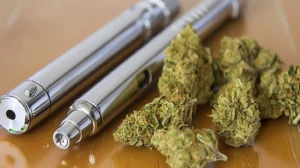Introduction Growing Basics
Cannabis, also known as marijuana, is a plant that contains psychoactive compounds, mainly tetrahydrocannabinol (THC) and cannabidiol (CBD). With the increasing legalisation and availability of cannabis, many people are showing interest in growing their own cannabis at home. Home cannabis growing not only allows you to have a constant supply of fresh and high-quality cannabis, but it also offers a sense of control and satisfaction.
Before starting, it is essential to understand the legal considerations for home cannabis growing. In the United States, the laws regarding cannabis cultivation vary from state to state. While some states have legalised both medical and recreational cannabis, others have stricter regulations. It is crucial to research and understand the laws in your state before starting to grow cannabis at home.
In addition to legal considerations, there are some basic requirements for growing cannabis at home. These include providing the ideal growing conditions, such as proper lighting, temperature, humidity, and air circulation. You will also need to invest in equipment and supplies, such as grow lights, ventilation systems, and soil or nutrient solutions. Choosing the right cannabis strain is also crucial for successful home growing. There are three main types of cannabis strains – sativa, indica, and hybrid. When choosing a strain, consider factors such as growing difficulty, yield, potency, and desired effects.
The process of growing cannabis at home involves four main stages – germination, vegetative stage, flowering stage, and harvesting and curing. Each stage requires specific care and attention to ensure a healthy and successful yield. It is essential to avoid common mistakes such as overwatering, nutrient deficiencies, and pest infestations.
To ensure successful home cannabis growing, it is important to follow certain tips, such as starting with a simple strain, keeping a grow journal, and researching and learning from experienced growers. Additionally, it is important to be prepared to deal with common problems that may arise, such as nutrient deficiencies, pests, and mould.
With this introductory guide, beginners can gain a better understanding of the basics of home cannabis growing. As you continue to learn and gain experience, you can improve your techniques and achieve a successful and satisfying home cannabis harvest.
What is Cannabis?
Cannabis, also known as marijuana, is a psychoactive drug derived from the Cannabis plant. It is primarily used for medical or recreational purposes. The main psychoactive component in cannabis is tetrahydrocannabinol (THC), which induces feelings of relaxation and euphoria when consumed. In addition to THC, cannabis contains cannabidiol (CBD), which is non-psychoactive and is believed to have various therapeutic effects. Cannabis can be consumed by smoking, vaporizing, within food, or as an extract. With the legalisation of cannabis in many places, it is important to understand the laws and regulations surrounding its use and cultivation. It’s essential to consider the potential health risks and benefits before using cannabis for any purpose.
Cannabis has been used for thousands of years for various purposes, including medicinal and spiritual practices, and as a source of fibre for textiles and rope.
What are the Benefits of Growing Cannabis at Home?
Growing cannabis at home offers numerous benefits, including:
- Quality control: You have full control over the growing process, ensuring the absence of harmful pesticides or chemicals.
- Cost-effectiveness: It can be more cost-effective in the long run compared to purchasing cannabis from dispensaries.
- Personalised strains: You can cultivate specific strains that are not easily available in the market, tailoring your cultivation to your preferences.
- Continuous supply: Ensures a consistent and personal supply of cannabis without relying on external sources.
If you’re considering growing cannabis at home, ensure compliance with legal regulations, use reputable sources for guidance, and prioritise safety in the cultivation process.
What are the Legal Considerations for Home Cannabis Growing?
When considering home cannabis growing, it’s crucial to understand the legal considerations. Research your local laws and regulations regarding the cultivation of cannabis for personal use. Some key legal aspects to consider include:
- The number of plants allowed
- Requirements for indoor versus outdoor cultivation
- Restrictions on selling or distributing the harvested cannabis
Additionally, be aware of zoning laws, which may dictate where and how cannabis can be grown on your property. It’s essential to comply with all legal requirements to avoid any potential legal consequences. Remember, staying informed about the legal framework is vital to ensure a smooth and lawful home cultivation experience.
Fact: In some regions, growing cannabis at home is legal for personal use, but selling it without the appropriate licenses is prohibited.
What are the State Laws on Home Cannabis Growing?
State laws on home cannabis growing vary widely across the United States. It’s crucial to research and understand the specific regulations in your state.
Some states, such as California, allow adults to cultivate a limited number of cannabis plants for personal use. Conversely, other states like Idaho completely prohibit home cultivation. Additionally, certain states require individuals to obtain a license or permit before growing cannabis at home.
Before embarking on home cannabis cultivation, familiarise yourself with the legal framework to ensure compliance and avoid potential legal consequences. Stay updated on any changes in state laws related to home cannabis growing to ensure that you are operating within the legal boundaries. For further details, refer to official government sources or consult with legal professionals specialising in cannabis regulations.
What are the Federal Laws on Home Cannabis Growing?
In the United States, federal laws on home cannabis growing strictly prohibit cultivation, possession, and use of cannabis, regardless of state laws. The federal government categorises cannabis as a Schedule I controlled substance, posing challenges for individuals growing cannabis at home. Understanding these laws is crucial to avoid legal repercussions and fines. As a suggestion, always stay informed about the current federal regulations and seek legal counsel if unsure about compliance.
What are the Basic Requirements for Growing Cannabis at Home?
To cultivate cannabis at home, make sure you have the following basic requirements:
- A suitable growing space with sufficient ventilation and lighting
- High-quality cannabis seeds or clones
- Nutrient-rich soil or a hydroponic system
- A proper watering and feeding schedule
- Necessary permits or legal requirements
Additionally, invest in essential growing equipment such as pH testers, humidity monitors, and trimming tools. Remember to research and comply with local regulations regarding home cannabis cultivation.
Did you know that the ideal temperature for growing cannabis plants is between 70-85°F (21-29°C) during the day and slightly cooler at night? This temperature range encourages optimal growth and flowering for cannabis plants.
What are the Ideal Growing Conditions for Cannabis?
The ideal growing conditions for cannabis include:
- Temperature: Maintain a consistent temperature between 70-85°F during the day and about 10-15°F cooler at night.
- Humidity: Keep the humidity levels between 40-60% during the vegetative stage and around 40% during the flowering stage.
- Air Circulation: Ensure good air circulation to prevent mold and mildew, using fans or an exhaust system.
- Light: Provide 18 hours of light during the vegetative stage and 12 hours of uninterrupted darkness during the flowering stage.
- Soil and Nutrients: Use well-draining, nutrient-rich soil with a pH level between 6-7 and provide appropriate nutrients during different growth stages.
What Equipment and Supplies Do You Need for Home Cannabis Growing?
To start home cannabis growing, essential equipment and supplies include:
- Grow lights
- Pots
- Soil
- Nutrients
- pH testing kit
- Thermometer
- Hygrometer
- Fan for air circulation
Reflective material and a grow tent or space with good ventilation are also vital. Additionally, consider a water filtration system, pruning shears, and gloves for plant maintenance. When choosing equipment, prioritize energy-efficient LED grow lights, fabric pots for better aeration, and organic soil for natural growth. Lastly, ensure proper storage for seeds and harvested cannabis.
Pro-tip: Research and invest in quality equipment and supplies, as they are crucial for successful and healthy home cannabis cultivation.
How to Choose the Right Cannabis Strain for Home Growing?
Identify growth space: Assess the available space for cultivation, considering height, width, and ventilation. Compact spaces may suit Indica-dominant strains, while Sativa-dominant strains could thrive in more vertical space.
Climate considerations: Analyse the local climate and select a strain that can thrive in the available conditions. For instance, if the climate is cooler, opt for a strain that is resistant to lower temperatures.
THC/CBD ratio: Determine the desired effects and medicinal benefits. Strains with higher THC levels offer a more euphoric experience, while those with higher CBD levels are valued for their therapeutic properties.
Growth difficulty: Evaluate personal experience and expertise in cannabis cultivation. Beginners may prefer easy-to-grow strains like Northern Lights, while experienced growers might opt for more complex strains like Amnesia Haze.
What are the Different Types of Cannabis Strains?
When exploring cannabis strains, it’s essential to understand the different types available. Varieties include Cannabis indica, Cannabis sativa, and hybrid strains.
Indica strains typically offer relaxing and sedative effects, making them suitable for evening or nighttime use. On the other hand, sativa strains often provide energising and uplifting effects, making them ideal for daytime consumption. Hybrid strains, a combination of indica and sativa, offer a blend of effects. Factors such as cannabinoid and terpene profiles influence the unique properties of each strain.
When selecting a strain, consider the desired effects, potency, flavour, and aroma to find the most suitable option for personal preferences and wellness goals.
What Factors Should You Consider When Choosing a Cannabis Strain?
When choosing a cannabis strain for home growing, consider factors such as the plant’s genetics, growth characteristics, and intended use. Evaluate the strain’s THC and CBD levels, as higher THC strains offer stronger psychoactive effects, while CBD-rich strains provide medicinal benefits without the high. Additionally, assess the strain’s suitability for your growing environment, whether indoors or outdoors, and its resistance to pests and diseases. Consider the flowering time, yield potential, and aroma profile to align with your preferences and cultivation capabilities.
Examples of factors to consider when choosing a cannabis strain include:
- The strain’s cannabinoid profile
- Growth traits
- Environmental adaptability
What are the Steps for Growing Cannabis at Home?
So, you’re interested in growing cannabis at home? The process may seem daunting, but with the right knowledge and tools, it can be a rewarding and enjoyable experience. In this section, we will break down the steps for growing cannabis at home into four key stages: germination, vegetative stage, flowering stage, and harvesting and curing. Each stage plays a crucial role in the growth and development of your cannabis plant, and we’ll discuss the important factors to consider in each step. Let’s get started on your home cannabis growing journey.
1. Germination
When germinating cannabis seeds, follow these essential steps:
- Select quality seeds from reputable sources to ensure viability and genetic integrity.
- Use the paper towel method or pre-soak seeds in water to initiate the germination process.
- Place the seeds in a warm, dark, and damp environment to prompt sprouting.
- Monitor the seeds daily and ensure they remain moist but not waterlogged.
- Once the taproot emerges, handle the seeds with care to avoid damaging the delicate roots.
2. Vegetative Stage
During the vegetative stage of cannabis growth, the following steps are crucial:
- Provide a consistent light cycle of 18-24 hours of light per day to promote leafy growth.
- Maintain a temperature between 70-85°F (21-29°C) and humidity levels around 40-70% to encourage healthy development.
- Regularly water the plants, ensuring that the soil is consistently moist but not waterlogged, and avoid overfeeding during this stage.
- Prune and train the plants to encourage bushier growth and maximize light exposure to lower branches.
Fact: The vegetative stage is essential for establishing a strong foundation for robust flowering and a successful harvest.
3. Flowering Stage
- Transition: As the flowering stage begins, adjust the light cycle to 12 hours of light and 12 hours of darkness to simulate the changing season.
- Gender Identification: Monitor the plants for gender as only the females produce the desired flowers.
- Pruning: Trim any unnecessary leaves to promote better airflow and prevent mold and mildew during the flowering process.
- Nutrient Adjustment: Increase phosphorus and potassium intake while reducing nitrogen levels to support flower development.
- Pest Control: Continue monitoring for pests and diseases, implementing necessary measures to protect the flowering plants.
4. Harvesting and Curing
Harvesting: Harvest cannabis plants when the trichomes are cloudy or amber in colour. Use a magnifying glass to check trichome colour for the perfect time to harvest.
Curing: Trim the harvested buds and hang them upside down in a dark, cool, and well-ventilated area. After drying, place the buds in airtight containers for curing, opening the lids periodically to release moisture.
For optimal results, ensure a precise harvesting and curing process to enhance the flavour, potency, and overall quality of the harvested cannabis.
What are the Common Mistakes to Avoid When Growing Cannabis at Home?
When cultivating cannabis at home, it is important to avoid common mistakes in order to ensure a successful yield and a positive experience. Here are some mistakes to avoid:
- Overfeeding: Avoid overfeeding your plants as it can result in nutrient burn and other issues.
- Overwatering: Overwatering can suffocate the roots and lead to root rot, so maintain a balanced watering schedule.
- Ignoring pH Levels: Monitoring and adjusting pH levels is crucial for nutrient absorption.
- Poor Ventilation: Inadequate airflow can lead to mould, so ensure proper ventilation in the growing area.
- Improper Light Distance: Placing lights too close or too far can harm the plants, so ensure the appropriate distance.
Fact: Maintaining a well-ventilated and properly lit growing space is crucial for the healthy growth of cannabis plants.
What are the Tips for Successful Home Cannabis Growing?
Start with quality seeds or clones from a reputable source.
Ensure the grow space has proper ventilation, lighting, and temperature control.
Use nutrient-rich soil or hydroponic system for healthy plant growth.
Regularly monitor and adjust pH and nutrient levels.
Prune and train the plants to promote better airflow and light penetration.
Be mindful of pests and diseases; implement preventive measures.
Harvest at the right time by observing trichome color and maturity.
Pro-tip: Research and understand the specific needs of the chosen cannabis strain to optimize the growing process and yield.
How to Deal with Common Problems in Home Cannabis Growing?
Identify the Problem:
Regularly inspect plants for signs of common issues such as nutrient deficiencies, pests, or diseases.
Research Solutions:
Utilise reliable sources to understand and address specific problems. Consider factors like pH levels, temperature, and humidity.
Implement Corrective Measures:
Adjust feeding schedules, watering practices, or environmental conditions based on the identified problem.
Seek Community Support:
Engage with online forums, local grow clubs, or seek advice from experienced growers to troubleshoot and find effective solutions.
Maintain Documentation:
Keep a grow journal to track plant development, issues encountered, and the effectiveness of implemented solutions for future reference.
.jpg)
Frequently Asked Questions
What is the legal status of growing cannabis at home?
The legal status of growing cannabis for personal use varies by state. It’s important to check with your state laws and regulations before starting to grow at home.
What is the recommended space and equipment for beginner home growers?
For beginner home growers, a small space with access to electrical outlets and a water source is recommended. Basic gardening tools and a grow room with standard fans and carbon filters are necessary equipment.
How many cannabis plants can I legally grow at home?
The number of cannabis plants allowed to be grown at home varies by state. In most states, it is legal to grow a small number of plants for personal use. It’s important to check with your state laws before starting to grow.
What is the watts per square foot method and how is it used in cannabis growing?
The watts per square foot method is used to determine the amount of light needed for the cannabis canopy. It is calculated by dividing the total watts of the grow lights by the square footage of the growing space. This method helps ensure the plants receive enough light for optimal growth and yield.
What are some practical reasons for growing cannabis at home?
Growing cannabis at home can be a cost-saving and rewarding hobby. It also allows for more control over the quality and strain of the final product. Additionally, with ever-changing laws, having the ability to grow at home can serve as an escape route for those who may not have access to a local dispensary or a medical card.
What is the recommended lighting for beginner cannabis growers?
LED lights are generally recommended for beginner cannabis growers. They are cost-effective, produce full spectrum light, and are easy to set up. However, they may not include UV or infrared light, which can impact yield. It’s important to choose high-quality full spectrum lights for optimal results.
Dive into the world of home cannabis cultivation with confidence! Subscribe to our newsletter and receive regular updates filled with essential growing basics, expert tips, and insider knowledge to ensure your indoor garden flourishes. Don’t miss out on becoming a cannabis growing pro!






